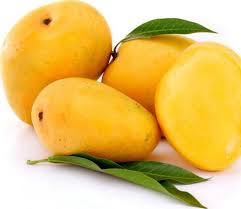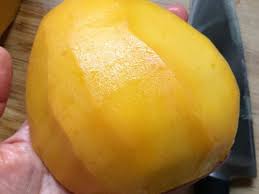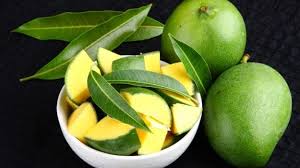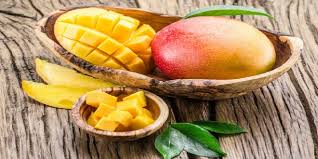In some parts of the world, mango (Mangifera indica) is called the “king of fruits.” It’s a drupe, or stone fruit, which means that it has a large seed in the middle. Mango is native to India and Southeast Asia and has been cultivated for over 4,000 years. There are hundreds of types of mango, each with a unique taste, shape, size and color

Mango (Mangifera indica) is one of the most popularly consumed fruits in the world; its sweet, juicy flavor means mangoes are celebrated as both an important culinary ingredient and a food in their own right. Originating in India over 4,000 years ago, mango cultivation has gradually spread across the globe and now Mexico, Brazil, Australia, Israel, and the U.S. are all among the key producers of the fruit. But what benefits does mango offer besides low-fat flavor? Read on to discover the five important health benefits of mango that characterize it as a little-known super food.
Easily one of the most delicious and nutrient-dense fruits, mangoes are one of the most liked, no, loved fruits. Also known as the king of fruits, mangoes are not just popular for their taste and vibrant colours, but also for the abundance of health benefits it possesses.

Mangoes are rich in protein, fibres, vitamin C, vitamin A, folic acid, vitamin B-6, vitamin K and potassium. These fruits help in reducing the risk of lifestyle-related health conditions such as obesity, diabetes, heart disease. It also promotes a healthy complexion and hair, increased energy and helps in maintaining a healthy weight [1]. The mango season is about to bid us goodbye for this year and before that is over, let us take a look at how mangoes benefit your health. Read on to know the Health Benefits of Mango.
This fruit is not only delicious but also boasts an impressive nutritional profile.
In fact, studies link mango and its nutrients to health benefits, such as improved immunity, digestive health and eyesight, as well as a lower risk of certain cancers.
Here’s an overview of mango, its nutrition, benefits and some tips on how to enjoy it.
Nutrients
Mango is low in calories but full of nutrients.
One cup (165 grams) of sliced mango provides :
- Calories: 99
- Protein: 1.4 grams
- Carbs: 24.7 grams
- Fat: 0.6 grams
- Dietary fiber: 2.6 grams
- Vitamin C: 67% of the Reference Daily Intake (RDI)
- Copper: 20% of the RDI
- Folate: 18% of the RDI
- Vitamin B6: 11.6% of the RDI
- Vitamin A: 10% of the RDI
- Vitamin E: 9.7% of the RDI
- Vitamin B5: 6.5% of the RDI
- Vitamin K: 6% of the RDI
- Niacin: 7% of the RDI
- Potassium: 6% of the RDI
- Riboflavin: 5% of the RDI
- Manganese: 4.5% of the RDI
- Thiamine: 4% of the RDI
- Magnesium: 4% of the RDI
It also contains small amounts of phosphorus, pantothenic acid, calcium, selenium and iron.
One cup (165 grams) of mango provides nearly 70% of the RDI for vitamin C — a water-soluble vitamin that aids your immune system, helps your body absorb iron and promotes growth and repair.
IS MANGO NATIVE TO INDIA?
There are over 100 countries that currently produce mangoes, however, most of the world’s mangoes come from India! So, it comes as no surprise that the mango is the national fruit of India.
While India is at the forefront of mango distribution, it’s said that mangoes originally came from Asia and then went to the Middle East, East Africa, and South America with travelers around 300 or 400 A.D. From there, they came to the U.S. byways of Mexico, Ecuador, Peru, Brazil, Guatemala, and Haiti. There are, however, two ‘races’ of mangoes: one that originated in Asia and another that came about in India.
BENEFITS OF MANGO

Did you know that mangoes are a superfood? That means they have enough vitamins (B6, A, and C) and minerals (potassium, magnesium, and copper) to make them a very healthy choice in your diet. If you eat one cup of mangoes, that equals just 100 calories! Mangoes are known to aid in digestion, help with anemia, reduce acne, and promote brain health, among other things!
If you’re looking to gain weight, mangoes can also aid in that area.
HOW TO PICK A RIPE MANGO
Want to pick the best mango from the bunch? Use your nose instead of your eyes! Smell is the best way to tell if a mango is ripe or not. If your mango is ripe, it will smell sweet and will be a bit soft to the touch.
HOW TO RIPEN A MANGO
*So you tried your best, but you picked an unripened mango. It’s okay! There are ways to hurry along the ripening process for your stone fruit.
*Put it in a paper bag or wrapped in newspaper overnight on the counter
*Submerge it in a bowl of rice or popcorn kernels
*Microwave for 10 seconds. PSA: might not taste as great as it normally would
*If you’re in no hurry, just leave it out on the counter at room temperature
HOW TO CUT A MANGO

Cutting a mango really depends on how fancy you feel like being. There are two main ways to prepare your mango, the inside-out one you see all over Instagram, and the less fussy way.
Easy: Peel the mango entirely and cut each side off, leaving a thin middle strip where the core is. Dice into cubes and salvage as much as you can from the core middle piece as well.

Fancy: Cut ½ inch away from the core on each side. Like you would an avocado, cut a grid into each side without going through the skin. Flip inside out and serve or spoon out the cubes!
HOW TO STORE MANGOES
If you cut up your mangoes in advance, you can store them in your freezer because frozen mangoes make a tasty addition to your morning smoothie! Otherwise, you can store them whole at room temperature on the counter or cut up and in the refrigerator. If you do cut it up and store it in the refrigerator, it’s best to eat within one week.
HOW TO EAT A MANGO
By now, you’ve probably gathered that the fleshy yellow inside is the tasty part of the fruit! Do not eat the peel or the stone or you’ll be very disappointed. Once you’ve cut it up one of the ways we’ve suggested, you can add it to a fruit salad, juice, smoothies, tarts, or a more savory approach with rice for dinner. Of course, you can always just cut it up and eat it on its own!
Mangos win the title as the most popular fruit worldwide.And, for good reason! They have a unique flavor and fragrance compared to other fruits. Even among themselves, there are many varieties ranging from sweet and creamy to rich and spicy.
Most of the Mango fruit sold in the US come from Mexico, Peru, Ecuador, Brazil, Guatemala and Haiti. Though there are more, six varieties make up the most common mango varieties in the US marketplace. Even if you tried one type of mango and didn’t care for it, don’t give up completely; their nutritional benefits are worth a second chance. A different variety or a different preparation technique may be all that you need.
High in Antioxidants

Mango is packed with polyphenols — plant compounds that function as antioxidants.
It has over a dozen different types, including mangiferin, catechins, anthocyanins, quercetin, kaempferol, rhamnetin, benzoic acid and many others.
Antioxidants are important as they protect your cells against free radical damage. Free radicals are highly reactive compounds that can bind to and damage your cells.
Amongst the polyphenols, mangiferin has gained the most interest and is sometimes called a “super antioxidant” since it’s especially powerful.
The Nutrition and Health Benefits in Mangos
Study after study shows that taste is the #1 determinant of why we eat what we eat. It’s an added bonus when foods that taste good are also good for us. That’s the case with mango fruit. The proof is in the pigment. You just have to cut the fruit open to see it’s filled with phytochemicals. Carotenoids, known for their antioxidant qualities, give this fruit its yellow-orange color. These antioxidants are the nutrients that protect and repair cells from free-radical damage, and work to boost our immune system to keep us feeling fantastic. Who wouldn’t want that?

While the nutritional content of different mango varieties vary, they all contain important nutrients. In fact, a study comparing the nutritional value of five different mango varieties showed that all five varieties met the criteria as an “excellent source” of vitamin A and C. The Mexican grown Ataulfo variety ranked highest in both vitamin C (ascorbic acid) and beta-carotene.
Mangos also contain a variety of phenolics like ellagic acid and gallotannin – compounds that serve as the base for antioxidants. One phenolic specific to mangoes is mangiferin. This compound has been shown to possess anti-inflammatory and anti-cancer qualities that helps the support the body’s immune system.
There is currently a range of research in human subjects studying mangos’ effect on inflammatory bowel disease, glucose response on pre-diabetic subjects, and the health benefits of mango supplementation as it relates to weight loss, body composition and inflammation.
1. Manages Cholesterol Levels Mangoes have a high level of vitamin C, pectin and fibres that help in lowering the serum cholesterol levels. Fresh mangoes are also rich in potassium, which is a necessary component of the cell and body fluids. It helps in controlling the heart rate as well as blood pressure.
2. Treats Acidity Mango is rich in tartaric acid, malic acid as well as traces of citric acid that help in maintaining the alkali reserve of the body by avoiding acidity issues. Alkalising your body is important because certain foods can create acidic byproducts in your body after digestion that can disturb the digestion process. Eating mangoes can help reduce the negative health effects of these acids.
3. Aids Digestion Mangoes are rich in fibrous matter pectin, which helps to break down the food in the system. Mangoes also contain several enzymes that help in breaking down protein, such as amylases that can help aid and improve your digestive health.

4. Supports Eye Health Mangoes are rich in vitamin A and one cup of sliced mangoes equals to 25 per cent intake of your daily need of vitamin A. Mangoes help in promoting good eyesight, fights dry eyes and also may help with night blindness. Mango is full of nutrients that help support healthy eyes.
Mangoes are also a good source of vitamin A, which supports eye health.

5. Improves Skin Health Mangoes are high in vitamin C, which promotes healthy skin. Vitamin C promotes the production of collagen, which in turn gives your skin its bounce and combats sagging and wrinkles. The antioxidants in the fruit also help protect hair follicles against damage from oxidative stress.
6. May Improve Immunity The combination of vitamin C, vitamin A as well as 25 different kinds of carotenoids present in mango is said to help in keeping the immune system healthy. Being a good source of immune-boosting nutrients, the king of fruits can help fight infections. Mangoes also contain folate, vitamin K, vitamin E and several B vitamins, which help improve immunity.
7. May Improve Heart Health Mangoes are good sources of potassium and magnesium, which help towards maintaining a healthy pulse and also in promoting blood pressure levels by relaxing the vessels. The unique antioxidant called mangiferin in mangoes may protect heart cells against inflammation, oxidative stress and cell death
8. May Help Reduce (Certain) Cancer Risk Mangoes are high in polyphenols, which have been proven to possess anti-cancer properties. These polyphenols can help protect against oxidative stress, studies point out. Animal studies reported that mango polyphenols reduced oxidative stress and stopped the growth or destroyed various cancer cells.
Is Eating Too Much Mangoes Bad For Your Health?
Eating too many of anything, especially fruits with a high sugar content can be harmful especially for those suffering from diabetes or weight problems. Health experts suggest that mangoes are high in sugar and must be eaten in moderation. Diabetic and obese individuals should limit or control their consumption of mangoes to avoid the risk of health complications. People with nut allergies should avoid mangoes as they are of the same family as pistachios or cashews. Some people with latex allergies have also had a cross-reaction to mangoes. So, is it okay to eat mango every day? Mango is one of the sweetest fruits and low in fibre than other fruits, therefore, it is healthy to not exceed two servings a day. An adult can eat 1 ½ to 2 cups of fruit per day.
